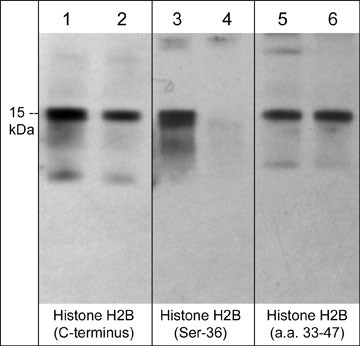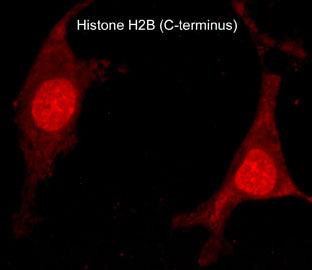Anti-Histone H2B (C-terminus) Antibody
- SPECIFICATION
- CITATIONS
- PROTOCOLS
- BACKGROUND

Application
| WB |
|---|---|
| Primary Accession | P33778 |
| Reactivity | Bovine, Chicken, Drosophila |
| Host | Rabbit |
| Clonality | Rabbit Polyclonal |
| Isotype | IgG |
| Calculated MW | 13950 Da |
| Gene ID | 3018 |
|---|---|
| Other Names | HIST1H2BB, H2BFF, Histone H2B type1B, H2B/f |
| Target/Specificity | The nucleosome is a protein complex consisting of four core histones (H2A, H2B, H3, and H4). Two molecules of each histone forms an octamer that makes up the nucleosome. DNA wraps around repeating nucleosome units to generate chromatin structures. The structure of chromatin determines the accessiblity to transcription factors. Post-translational modification of the amino-terminal tail of histones in nucleosomes alters chromatin structure to promote or inhibit transcription. Complex alterations in acetylation, methylation, ubiquination, and/or phosphorylation determine the chromatin structural changes that occur during specific phases of the cell cycle or in response to cell stimuli. One mode of regulating histone H2B activity is through phosphorylation in the amino terminal region. Important sites of phosphorylation include Ser-14, Ser-32, and Ser-36. AMPK phosphorylates Ser-36 on histone H2B during cell stress leading to increased transcription and cell survival, while ectopic expression of an unphosphorylatable histone H2B during cell stress reduces transcription of AMPK-dependent genes and lowers cell survival. |
| Dilution | WB~~1:1000 |
| Storage | Maintain refrigerated at 2-8°C for up to 6 months. For long term storage store at -20°C in small aliquots to prevent freeze-thaw cycles. |
| Precautions | Anti-Histone H2B (C-terminus) Antibody is for research use only and not for use in diagnostic or therapeutic procedures. |
| Shipping | Blue Ice |

Thousands of laboratories across the world have published research that depended on the performance of antibodies from Abcepta to advance their research. Check out links to articles that cite our products in major peer-reviewed journals, organized by research category.
info@abcepta.com, and receive a free "I Love Antibodies" mug.
Provided below are standard protocols that you may find useful for product applications.
Background
The nucleosome is a protein complex consisting of four core histones (H2A, H2B, H3, and H4). Two molecules of each histone forms an octamer that makes up the nucleosome. DNA wraps around repeating nucleosome units to generate chromatin structures. The structure of chromatin determines the accessiblity to transcription factors. Post-translational modification of the amino-terminal tail of histones in nucleosomes alters chromatin structure to promote or inhibit transcription. Complex alterations in acetylation, methylation, ubiquination, and/or phosphorylation determine the chromatin structural changes that occur during specific phases of the cell cycle or in response to cell stimuli. One mode of regulating histone H2B activity is through phosphorylation in the amino terminal region. Important sites of phosphorylation include Ser-14, Ser-32, and Ser-36. AMPK phosphorylates Ser-36 on histone H2B during cell stress leading to increased transcription and cell survival, while ectopic expression of an unphosphorylatable histone H2B during cell stress reduces transcription of AMPK-dependent genes and lowers cell survival.
If you have used an Abcepta product and would like to share how it has performed, please click on the "Submit Review" button and provide the requested information. Our staff will examine and post your review and contact you if needed.
If you have any additional inquiries please email technical services at tech@abcepta.com.













 Foundational characteristics of cancer include proliferation, angiogenesis, migration, evasion of apoptosis, and cellular immortality. Find key markers for these cellular processes and antibodies to detect them.
Foundational characteristics of cancer include proliferation, angiogenesis, migration, evasion of apoptosis, and cellular immortality. Find key markers for these cellular processes and antibodies to detect them. The SUMOplot™ Analysis Program predicts and scores sumoylation sites in your protein. SUMOylation is a post-translational modification involved in various cellular processes, such as nuclear-cytosolic transport, transcriptional regulation, apoptosis, protein stability, response to stress, and progression through the cell cycle.
The SUMOplot™ Analysis Program predicts and scores sumoylation sites in your protein. SUMOylation is a post-translational modification involved in various cellular processes, such as nuclear-cytosolic transport, transcriptional regulation, apoptosis, protein stability, response to stress, and progression through the cell cycle. The Autophagy Receptor Motif Plotter predicts and scores autophagy receptor binding sites in your protein. Identifying proteins connected to this pathway is critical to understanding the role of autophagy in physiological as well as pathological processes such as development, differentiation, neurodegenerative diseases, stress, infection, and cancer.
The Autophagy Receptor Motif Plotter predicts and scores autophagy receptor binding sites in your protein. Identifying proteins connected to this pathway is critical to understanding the role of autophagy in physiological as well as pathological processes such as development, differentiation, neurodegenerative diseases, stress, infection, and cancer.



